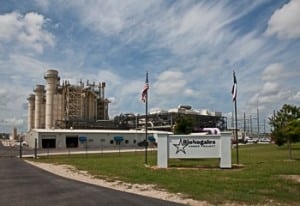Texas Utility Ready to Ramp Up Renewables
The CEO of Texas-based CPS Energy said March 6 that the utility wants to generate at least 50% of its power from renewable sources by 2040, part of a plan that includes the addition of 550 MW of battery storage, as it looks to reduce its dependence on fossil fuels. But the city-owned San Antonio utility will continue to operate coal and natural gas-fired power plants, though the city’s mayor has said he would oppose building more fossil fuel-powered units.
CPS CEO Paula Gold-Williams outlined the company’s “flexible path” strategy in a meeting with the utility’s board of directors on Tuesday. The utility last year announced it would close its two coal-fired units at the 840-MW Deely station (Figure 1) in San Antonio, one of several Texas coal plants being retired this year, though it will continue to operate two natural gas-fired units—the Sommers Gas Plant—at the site, with generation capacity of 892 MW.
CPS also will continue to operate two coal-fired units at the J.K. Spruce plant on Calaveras Lake in Bexar County, although its plan shows Unit 1 will be closed in 2030 instead of its originally scheduled retirement in 2047. Unit 2 at Spruce was named a POWER Top Plant in 2011, and CPS executives have said they expect to operate Unit 2 until 2042. The unit is considered among the cleanest-burning coal units in the U.S. It began operation in 2010 and uses low-sulfur coal from Wyoming’s Powder River Basin. The $1 billion project was built with the latest state-of-the-art emissions control equipment.
Gas-Fired Plants Will Continue to Operate
The company operates three natural gas-fired units at its 847-MW V.H. Braunig plant south of San Antonio. The three units are the oldest in the CPS fleet, coming online between 1966 and 1970. The company has said it could retire those units by 2030. CPS also operates the 800-MW Rio Nogales combined cycle gas plant (Figure 2) in Seguin, which it purchased from Tenaska Capital Management in 2012 as part of the plan to replace generation from the Deely station, and the 550-MW natural gas-fired Arthur Von Rosenberg plant in San Antonio.
San Antonio Mayor Ron Nirenberg, who was elected last year, has consistently reiterated his opposition to building more fossil fuel-powered units built to serve the city, saying his priority is a “balance” of power generation that “continues to keep the power clean and affordable.”
Gold-Williams unveiled what CPS calls its Flexible Generation Plan in a presentation to the company’s board. She said the utility is “keeping our powder dry” as it looks at its power generation over the next two decades, moving away from what she called a “build it and they will come” model.
“We’ll be able to implement large-scale energy solutions if that’s the best economic decision for this community,” Gold-Williams said. “However, we will also be able to think about scale and size in a way that we’ve never done before.”
Additional 4,100 MW of Renewables
The plan expects that the utility’s power generation portfolio by 2040 would include at least 50% solar and wind, which includes the addition of 4,100 MW of renewables. The plan calls for CPS to produce 13% of its power from natural gas, 9% from nuclear, 7% from coal, and 5% from energy storage. The remaining 16% would be what CPS Energy COO Cris Eugster called “flexible generation.” Eugster said that percentage would serve as a placeholder for new generation technologies, or new storage, that could be introduced over the next several years.
“We will not be building a large baseload power plant again. I think we can say that pretty confidently,” Eugster told local media prior to Tuesday’s meeting. “I think how we add capacity in the future to meet our load, our preference is to do it with renewables, with solar, but we need to do it in a way that’s affordable for our community and in a way that we get reliable power.” Eugster also said, “Our belief is our traditional fleet [of coal and natural gas units] is really our bridge into our future.”
CPS currently produces 22% of its power from renewable sources. Its present portfolio includes 45% natural gas-fired generation, 18% coal, and 15% nuclear, according to the utility. It added about 500 MW of utility-scale solar power through contracts with San Antonio-based OCI Solar Power between 2010 and 2017. The utility said it added 1,059 MW of wind power from 2002 to 2012, but it has not added any wind power since.
Local environmentalists said the CPS plan does move fast enough in transitioning from fossil fuels to renewables.
“The plan presented to the board of trustees [Tuesday] shows that CPS Energy isn’t leading on climate action, despite its involvement in the SA Climate Ready process,” Kaiba White, an Austin-based energy policy specialist for Public Citizen, said in a statement. “Instead, the utility plans to burn coal until at least 2042 and wants to invest in a significant amount of new natural gas generating capacity.”
Greg Harman, a spokesperson for the Sierra Club in San Antonio, in a statement said CPS is “overlooking a golden opportunity to launch a serious clean-energy economy. CPS Energy is putting off the acquisition of additional utility-scale renewable energy for far too long and is intent on relying on dirty coal through 2042 despite its public-health risks.”
—Darrell Proctor is a POWER associate editor (@DarrellProctor1, @POWERmagazine

